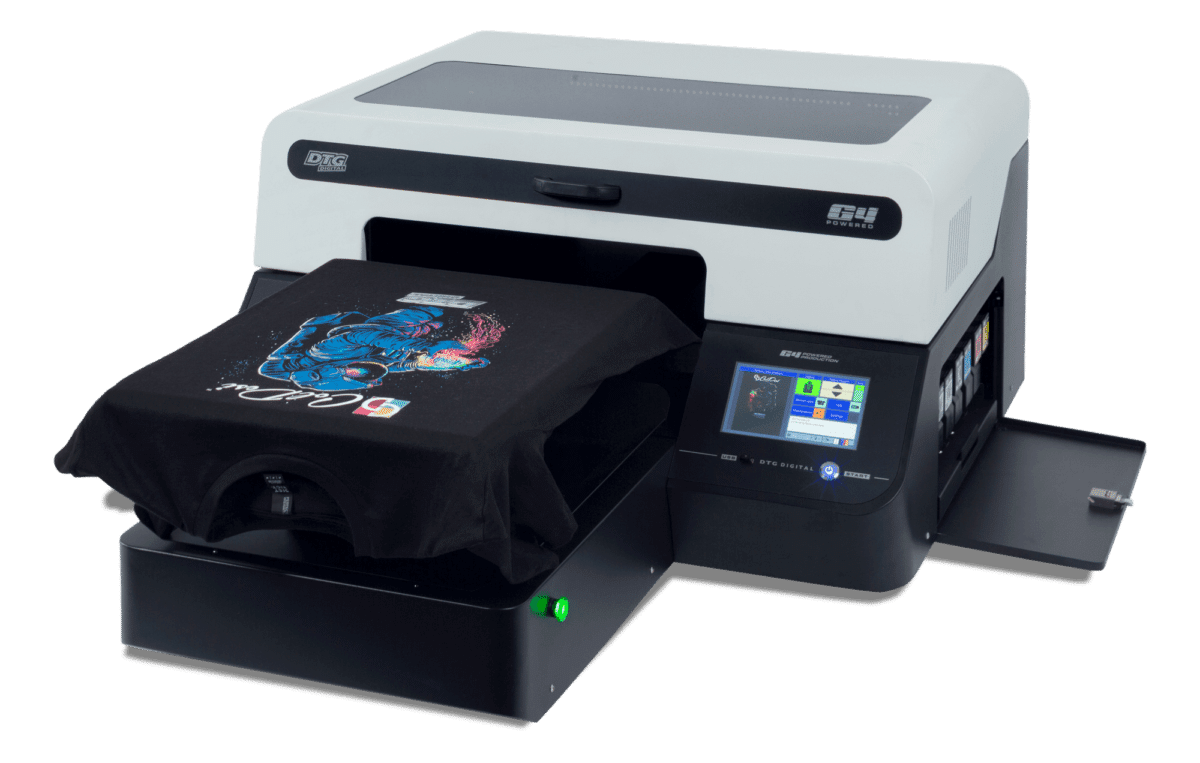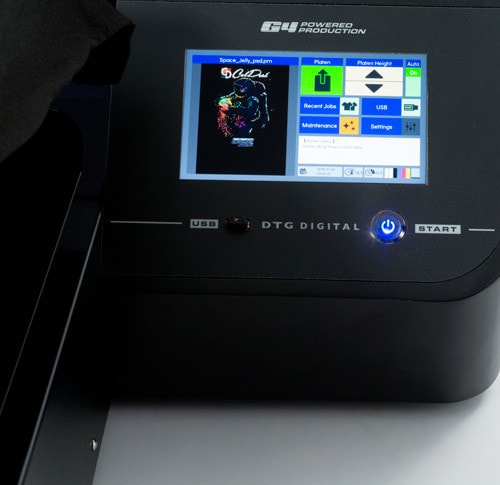T-Shirt Printer Comparison 2020 [Brother GTX vs. DTG G4]
The Brother GTX DTG Printer was released in 2017 and made a significant impact on the Direct to Garment printer marketplace. At the time, the machine offered a nice bump in print speed.
It’s fair to say that the upgrade from the Brother GT-381 (and similar models) was significant and set them well apart from the crowd.
That is, until the release of the DTG G4.
While Brother doesn’t have quite as many years in the direct to garment industry as DTGDigital and ColDesi, they’ve applied that experience well to the GTX printer.
Before the release of the DTG G4, it was by far the fastest printer in its class for return on investment speed of actual PRINTING, but more realistic measurements of productivity and workflow now put the GTX in second place at best.
DTG Printer Maintenance and its Impact on PRODUCTION
Maintenance is always top-of-mind for business owners when investigating DTG for their custom t-shirt shops.
And the big difference here between the Brother GTX and the DTG G4 is that the GTX requires you to spend tons more time and money on protecting the print-head.
Maintenance on the GTX is up to 10% to 25% of your time EVERY DAY you print, to meet those requirements.
The Problems With White Ink
The white pigment ink used to produce vibrant colors on dark-colored t-shirts is made with titanium. And up until the new G4 inks, that presented some real problems.
Also, the ingredients in the white ink tend to separate and settle over time, so they MUST be stirred or agitated in some way to stay mixed. If not, then that sediment can get into the ink lines and print heads to cause problems.
That leads to increased clogs and can cause the printhead to wear down faster. Not to mention, you have to use lots more white ink to make the underbase so that the colors will pop.
Today’s G4 DTG Ink itself helps prevent that. It’s designed to work WITH the printhead and is engineered in such a way that the maintenance is GREATLY reduces. And so it the potential for printhead dameage.
And because the G4 Inks are technologically superior, the white ink cartridges require very little attention.
Not so for the GTX.
The white pigment ink used to produce vibrant colors on dark-colored t-shirts is made with titanium. And up until the new G4 inks, that presented some real problems.

White Ink Maintenance Comparison
As part of the daily start-up procedure and periodically throughout the day, both the Brother GTX and the G4 control panels will tell you it’s time to “agitate the white ink”.
The G4’s white ink maintenance is much easier.
- Step 1: Take out the white cartridge
- Step 2: Shake it about ten times
- Step 3: Put it back
- Step 4: Repeat on White Cartridge #2

The Brother GTX requires more than 10x the effort:
- Step 1:Take out the white cartridge
-
Step 2: Hold the cartridge horizontal and shake it ONE HUNDRED times. The instructions say to do it GENTLY, because you may break the ink pouch inside. They actually make a point of saying that the swing distance should be no more than 2 inches unless the ink volume is low.
Oh, and wear gloves, just in case... - Step 3: Put it back
- Step 4: Repeat on White Cartridge #2
- Step 5: EXCEPT: if your remaining ink volume is under a certain amount, you’ll have to disassemble the ink cartridge, unroll the bag of ink and agitate it 100 times. Then reroll the bag properly, reassemble the cartridge and then put it back.
This is not an exaggeration. Here’s the link to the Brother GTX Maintenance procedures.
Automated Maintenance has also put a big dent in how much time it takes to care for your printer. But in the case of the Brother GTX, they’re standard routines cause massive downtime when the machine should be printing.
Automatic Head Cleaning
Automated maintenance has taken much of the work out of DTG printer care.
Basically, the equipment runs a cleaning procedure periodically, all by itself. Typically, this only takes a few minutes.
The critical thing to note is the difference in requirements for automated maintenance and how much ink each machine uses while doing it. Here’s the breakdown:
DTG G4 Automatic Cleaning-White:
• Frequency: Every six hours of non-use
• Time: Under 2 minutes for both white
• Ink Use: Under .8ml
• The clock resets every time you print
Brother GTX Automatic Cleaning:
• Frequency: Every 24 Prints
• Time: Between 6 and 15 minutes
• Ink Use: Unknown
• The clock resets every time you print

How Does Machine Maintenance Schedules Affect Production Time?
The print time of the GTX vs the G4 machine similar until you consider the effect that each of their maintenance schedules has on overall production. The same goes for Hooping and Print Curing times. Also very close between the G4 and Brother GTX.
For example, you will need to cure a printed shirt with a heat press for :45 seconds with the G4 and :35 seconds with the GTX.
They both print an image on a dark shirt in almost the same times, and both are over :45 seconds for any reasonably sized print. That means the ten seconds shorter cure time on the GTX doesn’t impact production time. You’re still going to be curing longer than it takes to print a shirt.
What About Hooping?
And while hooping time on the G4s vacuum platen is probable a few seconds faster than the platen/hanger configuration on the GTX, it’s also probably close enough you won’t notice a difference.
The fact that the Brother GTX is required to stop production to perform an auto-clean after you print every 24 shirts DOES make a difference. And it’s a big one.
Let’s say your printing 25 shirts per hour.
That’s a reasonable pace if you pretreat in advance, and you are an average operator. So, if you’re printing cycle is 2 minutes, you could produce about 200 shirts in an 8 hour day.
However, because of the wasted time doing maintenance on the GTX, you're actually printing 10% to 25% FEWER shirts in the same time frame.
All other things being equal, with the Brother GTX, the best you’ll be able to do is produce 180 shirts in that same 8 hours. The printer is going to stop and clean itself for at least 6 minutes every 2 dozen prints.
The worst that might happen is that you’ll only be able to print 150 shirts in that 8-hour day because you happen to be at the top end of the auto clean estimated time at 15 minutes every 2 dozen prints.

It’s about your time and your money
Something else that sets the DTG G4 apart from the GTX (like G4 Inks and the Vacuum Platen®) is to reduce your maintenance time to almost nothing.
The only time the G4 runs that cleaning procedure is after 6 hours of NON-USE. So if you’re printing all day it will never interrupt you.
Not to mention, that quick shake of the G4 white ink cartridges takes just a few seconds, vs the 200 cycles required for the Brother cartridges. And that’s not including the EXTRA time you’ll need to set aside to take them apart to shake when your ink gets low.
But now there’s something better. Learn more about why you should invest in ColDesi and the DTG G4 here, then contact us.
Want to know more about the DTG G4?
Our professional team knows what makes a good direct to garment printer for your specific business needs. Click the chat button below, call (877) 458-0444 or select the button below to contact us.



